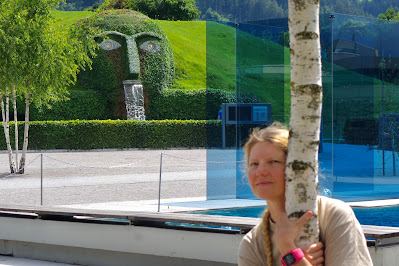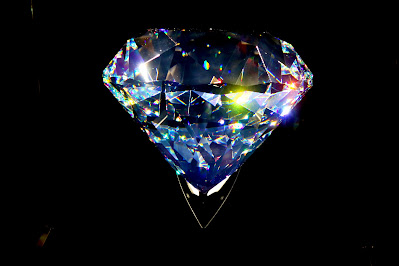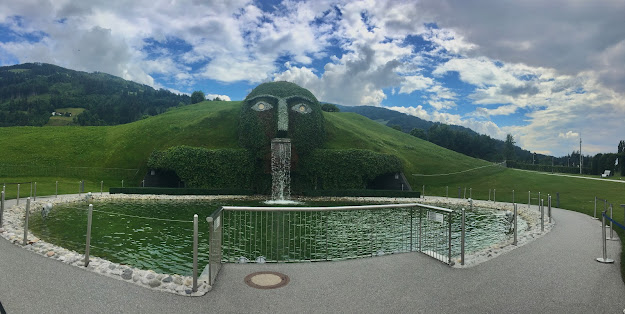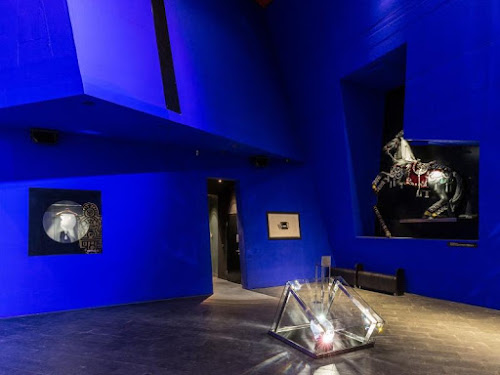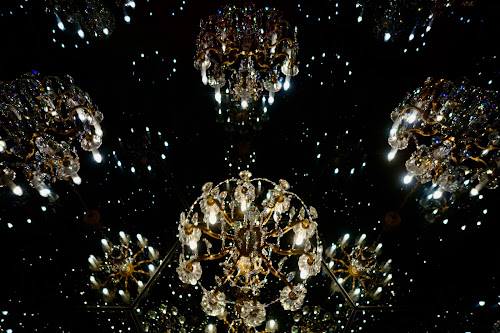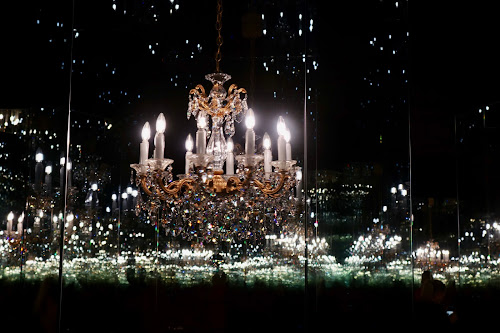Zell am See, 23rd of June 2020
I left Lermoos by car in the rainy Monday of yesterday driving back home to Zell am See. As the route over three high passes crossing the Alps is over 200 km and takes about three hours or longer I decide to split it into two segments and to stop at Swarowski Crystal Worlds - a worldwide known corporation for luxury products belonging to one of the richest families in Austria - being directly on my way back home and approx. 95 km away from Lermoos, still 110 km to drive until Zell am See.
Daniel Swarovski (24 October 1862 – 23 January 1956) was a Czech-born Austrian glass cutter, jeweller, and founder of the Swarovski crystal dynasty. Swarovski was born in Georgenthal at Gablonz, Bohemia, Austrian Empire (now Jiřetín pod Bukovou, Czech Republic), the son of Franz Swarovski and Helene Swarovski (née Staffen). He was born in the Jizera Mountains, 20 kilometres (12 mi) from the current border with Poland. Like many in the area, his father was a glass cutter, and Swarovski first learned the art of glass-cutting in his father's small factory. He was educated in Paris and Vienna, where he met Frantisek Krizik, and became interested in electricity at the 1883 Electricity Exhibition in Vienna. In 1887, Daniel Swarovski married Marie Weis, the sister of his business partner Franz Weis, and they had three sons: Fritz, Alfred, and Wilhelm.
In 1892 he patented an electric cutting machine that facilitated the production of lead crystal glass jewellery, which until then had to be cut by hand. In 1895 he immigrated to Austria and partnered with Armand Kosman and Franz Weis to form "A. Kosmann, D.Swarovski & Co." They built a crystal-cutting factory in Wattens, Tyrol, to take advantage of local hydroelectricity for the energy-intensive grinding processes Swarovski had patented.
In 1919, Swarovski founded the Tyrolit company, bringing the grinding and polishing tools from his crystal business into a different market. In 1949, Swarovski Optik KG was founded by his son Wilhelm Swarovski in Absam, in Tyrol. ******
I reached the Crystal Worlds shortly after 12 o'clock after a longer stop around Fernstein Castle, Ruin & Lake.
It wasn't easy to find a parking place in the huge parking area, so it was the first sign there are plenty of tourists there. But I was there, so I stayed.
It is an open-air large area nestled among mountains. The very lively green after the rain cleans your senses and I was pretty curious what I am going to experience in this place. I had no expectations whatever!
At the entrance, where the tickets are sold, the area was empty, only three-four people. Very enjoyable. The regular price is 19 Euros + 2 Euros for the audio guide, but the audio guide is included in the price this year and they also offer a special discount of 25% due to the 25th anniversary, so I paid about 14 Euros.
Because of the cloudy weather at that time the outdoor area seemed to really be almost empty. So I did small steps to the huge human head with the waterfall called The Giant - the symbol of this Swarovski Crystal Enterprise ..... Fascinated about the moment ..... wow, I am here .... I am finally here ...... Thank You!
The semnification of The Giant could be that of a Watcher. He takes care of all the treasures are hidden beneath the earth after collecting them during his worldwide journeys.
On the right and on the left side of The Giant are the entry points, so the entire exhibition is actually artificially undergrounded. So, let's begin the journey through the Chambers of Wonders - the name for the various spaces inside this museum of art - because we will meet the art as team-work: lights, mirrors, sounds, scents and ..... crystals, millions and billions of small, smallest, bigger and biggest crystals you ever knew exists!
One century later after the founding of the factory in Wattens, multimedia artist Andre Heller was commissioned to design the museum with fourteen chambers of wonder in the form of a giant to celebrate the 100th anniversary of D. Swarovski KG. After the initial opening in 1995, further expansion and renovation projects followed in 1998, 2003, and 2007. Inside The Giant, there are exhibition spaces, based on the concept of the historic chambers of art and curiosities favoured by aristocratic families in the 16th century. In the Chambers of Wonder at Swarovski Crystal Worlds, internationally and nationally recognized artists, designers, and architects, such as Brian Eno, Tord Boontje, Niki de Saint Phalle, Jim Whiting, Keith Haring, Andy Warhol, Salvador Dalí, and Yayoi Kusama, have interpreted crystal in their own ways. 17 showrooms - each of which has a different thematic focus. The original principle of these Chambers of Wonder is based on the historical chamber of wonders in the castle of Ambras, which was a sixteenth-century attempt to assemble a universal collection of all knowledge known at the time. In the Chambers of Wonder at Swarovski Crystal Worlds, internationally and nationally recognized artists, designers, and architects have interpreted crystal in their own unique ways. They create concepts of space and experience from the sparkling material. Cabinets of curiosities (also known in German loanwords as Kunstkabinett, Kunstkammer or Wunderkammer; also Cabinets of Wonder, and wonder-rooms) were notable collections of objects. The term cabinet originally described a room rather than a piece of furniture. Modern terminology would categorize the objects included as belonging to natural history (sometimes faked), geology, ethnography, archaeology, religious or historical relics, works of art (including cabinet paintings), and antiquities. The classic cabinet of curiosities emerged in the sixteenth century, although more rudimentary collections had existed earlier. In addition to the most famous and best-documented cabinets of rulers and aristocrats, members of the merchant class and early practitioners of science in Europe formed collections that were precursors to museums. The texts below meaning a possible interpretation of each object doesn't belong to me, I perceived them totally different. They are copied from the home page of the exhibition.
THE BLUE HALL
The world of the Giant begins in the Bue Hall, the first Chamber of Wonder. Its slanted walls painted in the colour of "international klein blue", a shade developed by the artist Yves Klein, suggest the inside of a cave.
The space offers an initial insight into the fascination of crystal and displays masterpieces such as Salvador Dali's "The persistence of time",
Niki de Saint Phalle's "Crystal-bearing Nana"
the black stallion “Chetak”
the Crystal Wall (a huge glass wall filled with crystals) and some other pieces.
The main piece is for sure the huge crystal in the middle of the hall, named "Centenar":
Due to the strong colours-lights-shadows-effect, the crystal is not easy to be captured in a good professional picture, so I had to scroll up and down through the internet.
With his 300.000 carats this is the world's largest produced crystal in the world.
And I was there, he was in front of me and I almost didn't see it due to the principle missing the forest because of the trees or what? My fascination is not about the crystal itself, but about the spirit of art.
In the same room with the biggest crystal in the world (40 cm diameter) there is also the smallest crystal in the world as a tiny component of a swan.
The dome of the Crystal Dome was modelled after Sir Richard Buckminster Fuller's (1895–1983) geodesic dome, whose architectural design perfectly reflects the principle of geodesy. Geodesy is the scientific discipline devoted to geographical measurement and representation of the Earth; in mathematics, it designates the shortest path between two points on a curved surface.

Geodesic domes are particularly stable, especially considering the relatively small amount of material used to build them. The dome of the Crystal Dome consists of 595 mirrors that create a special depth effect and give the viewer the feeling of being inside a crystal.
Eight of the mirrors are so-called “spy mirrors” that conceal fascinating art objects by various artists.
The music in the Crystal Dome was created by Brian Eno. Because it is such a spectacular backdrop, the Crystal Dome is a popular venue for weddings.
INTO LATTICE SUN
For “Into Lattice Sun”, South Korean lady artist Lee Bul looked to modern architecture as her muse, translating it into a metropolitan, dramatic, and utopian landscape for the Chamber of Wonder.
"The Infinity Wall" -
the installation of it consists of two overlappings and coated Japanese acrylic mirrors with Swarovski crystals in a variety of shapes placed between them.
Their placement, the mirroring effect, and the reflection of the crystals produce the illusion that small cities and even buildings are contained within the installation.

"Lee Bul’s encompassing installation explores the interactions between visitor and space. Myriad crystals and mirrors give the Chamber of Wonder the spatial illusion of ever new vastness and depths, inviting visitors to think about themselves and their position within the space."
This deliberately staged interplay of the continually changeable, iridescent mirror landscape enables the visitor to discover all of its facets from the most diverse perspectives.
"After Bruno Taut" -
the installation of it was inspired by the architectural fantasies of the German architect Bruno Taut (1880-1938). In his architectural works, Taut was concerned with, among other things, the use of glass as a building material - a significant innovation in modern architecture. The installation depicts the structure of the Earth using silver and aluminium strands, on which Lee Bul has placed a bizarre ice landscape made by crystals. The Earth is illuminated with a warm light, and a starry sky above the landscape directs the viewer's attention to the next installation.

The deeply symbolic bridge that leads us through this fascinating landscape of crystal and mirrors intensifies the visitor’s spatial experience.
"The Chandelier"
depicts an upside-down urban landscape consisting of interwoven crystals hanging from the ceiling and hails the conclusion of the Chamber of Wonder. The visitor is invited to interact with the installation and create his/her own interpretation of Lee Bul's narrative. From my point of view, I would never see in this chandelier "an upside-down urban landscape" really.

The chandelier is decorated with 350-400 individual crystal strands, with each strand combining many different crystalline elements. This city silhouette was inspired by 20th-century German expressionists and depicts a variation of architectural forms.

Another chandelier that I liked more, it is a classical form in my view - no information found.

"Chandelier Jungle" - a room with eight selected pieces as part of the project "Swarovski Crystal Palace".
Vincent Van Duysen's Cascade (bellow) s a stunning pillar of light that splashes out at the base, which is made out of approx. 28,800 clear crystals strung in four concentric rings. It's size: 280 x 50 x 50 cm -
CASCADE by Vincent van Duysen
Below, visitors are bathed in light emanated by the CASCADE chandelier, which was created for Swarovski Crystal Palace by Vincent van Duysen in 2003. The opulent piece, which is almost five meters tall, flows down from the ceiling like a waterfall. It is made up of strings of crystals combined with LEDs, so celebrating crystal and light in their most beautiful form, and tying in with the great tradition of the chandelier. CASCADE was used as a prop in the film “Ocean’s Thirteen” starring George Clooney and Brad Pitt in 2007.
The Ice Passage
At first glance, Tyrolean artist Oliver Irschitz's “Ice Passage” is an empty corridor; it does not come alive until you step inside. As you place your foot on the floor, a series of crystalline tracks start to appear, precisely revealing the path you have taken. The lights also trace these tracks, allowing the viewer to get sporadic glances into the surrounding world of glistening ice. The more visitors dare to venture in, the brighter and more luminescent the surroundings become, and the denser the tracks on the floor appear.
Each step that the visitor takes is accompanied by mysterious and sometimes alarming creaking and crackling – just as if you were actually on a frozen surface, with each step causing small fissures in the ice.

And this is the master-piece of the present exhibition:
The Chandelier of Grief
With Yayoi Kusama's only permanent “Infinity Mirror Room” in the world - in addition to her gallery in Tokyo - Swarovski Kristallwelten has opened it's now 17th Chamber of Wonder within the realm of the iconic Giant.
Kusama, one of the most popular contemporary artists in the world, is exhibiting one of her most spectacular mirror installations to date in Wattens, entitled "Chandelier of Grief".
"The central element is a rotating chandelier of Swarovski crystals, whose lustre comes to life in a room that is completely lined with mirrors.
The room creates the illusion of being in an endless space."
It is difficult to confirm the veridicity of this description because I couldn't feel the "endless space". I remained in the small dark room a few minutes. Yes, it is magic, but the space is much too tiny. It would be probably difficult to obtain the same effects in a larger space.
Only a limited number of nine persons are allowed to get inside at this moment and if you have another three persons besides you already is not a space to feel much anymore. 
The effects are great due to the mirrors and sounds, I agree. It is a place to get lost IF you want to get lost.The time I remained inside the other persons who came in declared a disappointment which I could understand.Due to the videos, they saw on the internet before coming to visit they expected something else, something totally different. Yes, this is marketing, unfortunately, and Austrians are champions in this field of illusions and attracting for fame and money.
The name “El Sol” is Spanish for “The sun.” Fernando Romero’s installation, formed from 2,880 custom-made Swarovski crystals, is an exploration of humankind’s relationship with the sun.
This large structure is exactly one billion times smaller than the sun itself. At the heart of the artwork is a sphere of LEDs, whose light is split by the inner facets of the precisely cut crystals in such a way that it creates a dynamic surface reminiscent of the sun.
The effect is realised by the sounds. There are original sounds registered from the Cosmos and played by a very slow pace, otherwise, the human ear could not perceive it.
The inspiration for El Sol was the remarkable geometry of the pyramids built by the Aztec and Mayan people. Romero’s creation is thus a homage to his Mexican cultural heritage. At the same time, his structure is also based on modern technologies. Three months of design and development were needed before the drawings were ready, and it took the technicians more than 350 hours to construct the artwork.
E D E N
The idea behind the Eden Chamber of Wonder is to create a landscape that evokes one of the strongest primal responses in man: the forest. But Eden is no ordinary forest – it is a fantastical, archaic primaeval world. At its entrance, a waterfall, filmed in the surrounding Alps, cascades down a screen and is reflected by the walls, while the roar of the water permeates the entire Chamber of Wonder, creating a wall of background sound.
Inside, the visitor follows a path that meanders through a dense wilderness of simple polished brass structures, which through mirrored walls appear to go on to infinity.
Within the depths of this dark forest, the wanderer encounters strange, hidden gems in the form of the biggest crystals Swarovski has ever produced.
They emerge as beacons of light from the dark, like strange, exotic birds, reptiles, flowers, or fruit, symbolizing the magnificence of nature and the origins of life.
There is for sure much more to tell you about what you can see inside The Giant, but then I should write a book about a visit of two - two and a half hours. And the content is changing anyway, this is only a small part of the present exhibition so that you get a taste of it. If you want to feel the feeling, you should go there in a period of time when the number of tourists is not so big. I was lucky actually, it wasn't much disturbance through a touristic mass and I could spend longer time inside, but I knew the outside is waiting for me too.
It is a place to smell, feel, get lost, imagine, wonder - this is for sure. It is not about the crystals as jewellery, as another product to be owned, it is about art and emotions.
********
It was sunshine through the clouds, warm and dry outside. So I took enough time to explore the entire park and to play, smell, remember, try, dream, wish, imagine, absorbing ....
In October 2014, the renovation and expansion of Swarovski Crystal Worlds began, at a cost of around 34 million euros, to celebrate the 120th anniversary of the Swarovski company, and the 20th anniversary of Swarovski Crystal Worlds itself.
It reopened on April 30, 2015. The overall area of the attraction was extended from 3.5 hectares to 7.5 hectares. New features added to the garden during this expansion included the “Crystal Cloud” made up of 800,000 crystals, a play tower, and the restaurant, Daniels Kristallwelten.
Dare to dream from now on inspired by the wild combination of colours in this late spring. Yes, we have almost the end of June, but the weather is very unstable, changeable, mystical and moody as we are. You could ask yourself if we are the one influencing the moods of the weather or if the weather influences us ....
Are we the ones creating this world we are passing through or the Universe creates us? No, it is not one of my most melancholic or philosophical days :-)
The excavations of Roman walls which were discovered while doing improvements in 2014 have also been opened to the public. They offer an important window on the history of the area. Apart from the walls, a cache of 702 Roman silver coins was found in what is thought to have been a small village along a main Roman thoroughfare.
These days the Swarovski management announced a huge "reorganisation" inside their corporation and about 600 people will lose their jobs there.
Spiele des Lichts in Kristall haben Daniel Swarovski wohl schon in seiner Kindheit fasziniert. Er wurde 1862 in Böhmen geboren, und im Elternhaus bestimmte Kristall das Leben.
Böhmen, damals Teilgebiet der Donaumonarchie Österreich-Ungarn, war eines der wichtigsten Zentren für die Glas- und Kristallherstellung. Und auch in der kleinen Fabrik des Vaters wurde Kristall geschliffen. Als Junge schaute Daniel oft im väterlichen Betrieb bei der Arbeit zu. Später absolvierte er sowohl hier als auch bei einigen anderen Kristallschleifern seine Lehrjahre. Und als er 21-jährig die "1. Elektrische Ausstellung" in Wien besuchte, hatte er die Idee seines Lebens: Die neuen Techniken von Siemens und Edison inspirierten ihn, eine Maschine zum Kristallschleifen zu entwickeln. Er verbrachte Tage und Nächte damit, seine Vision zu verwirklichen. Endlich, neun Jahre später (1892), konnte er ein Patent anmelden: Eine Maschine, die es erstmals ermöglichte, Kristallsteine in höchster Perfektion zu schleifen. Schneller und perfekter als bisher in mühevoller Handarbeit.
Damit begann eine neue Ära in der Welt des Kristalls. Der Grundstein für die heutige Firma war gelegt. Diese gründete Daniel Swarovski 1895 gemeinsam mit seinem Schwager Franz Weis und mit Armand Kosmann.
In 1895, Swarovski, financier Armand Kosmann, and Franz Weis founded the Swarovski company, originally known as A. Kosmann, D. Swarovski & Co. and shortened to KS & Co. The company established a crystal-cutting factory in Wattens, Tyrol (Austria), to take advantage of local hydroelectricity for the energy-intensive grinding processes Daniel Swarovski had patented. Swarovski's vision was to make "a diamond for everyone" by making crystals affordable. In 1899, it first used the edelweiss flower in its logo and expanded to France, where it was known as Pierres Taillées du Tyrol ("Cut stones from Tyrol"). In 1919, Swarovski founded Tyrolit, bringing the grinding and polishing tools from the crystal business into a different market.
In 1935, Swarovski's son Wilhelm created a customized pair of binoculars, which led to the launch of Swarovski Optik 14 years later. Swarovski Optik manufactures optical instruments such as binoculars, spotting scopes, rifle scopes and telescopes.
In 1977, Swarovski entered the jewellery market in the United States.
Nadja Swarovski, the founder's great-great-granddaughter, became the first female member of the Swarovski executive board in 2012.
****
Members of the Swarovski family were early, active and enthusiastic champions of National Socialism, and at least six of its members maintained membership in the illegal party prior to Austria’s annexation to National Socialist Germany on March 12, 1938. Three weeks earlier, 500 marchers in the Tyrolean town of Wattens held a torchlight procession that ended with chants of "Sieg Heil" and "Heil Hitler." The majority of the participants, police determined, were Swarovski plant employees, among them Swarovski family heirs Alfred, Wilhelm and Friedrich.
In its report to the state police on February 14, 1947, the Innsbruck district administrator called company head Alfred Swarovski “an enthusiastic member of the NSDAP." Alfred Swarovski praised Hitler at business gatherings and took actions as a regional business leader to ensure that “Tyrolean industry could be integrated as smoothly as possible into the enormous gears of the economy of Greater Germany and into the National Socialist economic order." He sent "grateful loyalty greetings" to Adolf Hitler on his 49th birthday and arranged a donation of 100,000 shillings for Hitler to establish a holiday home in Tyrol.
The company exploited its political connections and stewardship of the regional business association to emerge stronger from the Nazi era. During the war it diversified its production and expanded its business lines, adding abrasives, optical devices, telescopes, binoculars and other product lines during the war and growing from 500 to almost 1,200 employees between the Anschluss and March 1944.
"From my party affiliation, I only took advantage of the fact that it was possible for me as a party member to initiate the negotiations necessary for maintaining the company and to bring it to a successful conclusion with the responsible economic agencies of the Reich." - Alfred Swarovski told the Innsbruck People's Court after the war.
In 1994, historian Horst Schreiber wrote about Swarovski’s past but was not granted access to company archives.
The contemporary Swarovski company commissioned historian Dieter Stiefel as “a step towards dealing with our history in a serious and very proactive manner,” board spokesman Markus Langes-Swarovski said in 2018, however, the study was not published because, Langes-Swarovski said, “Swarovski is a company that generally tries to keep the owners' personal stories largely out of the public eye because it does nothing for the business.”
Swarovski Group’s website omits mention of the Nazi period in the “Our History” section, skipping the years between 1931 and 1949 on its timeline.
The Swarovski family's fortune is estimated at around 4.2 billion euros. Around 200 family members are working in and for the company. There are about 2.350 shops all over the world. With an annual turnover of ca 3,5 billion euros, the Swarovski crystal empire is one of the financially strongest luxury goods companies in the entire world.
Quelle 3
Quelle 4
Quelle 4 - 2nd picture of Centenar
Quelle 5 - about Chandelier Jungle Segment
****************
And this should be the World’s largest Swarovski chandelier inside the Sheikh Zayed Grand Mosque in Abu Dhabi, United Arab Emirates (by daveleau).
